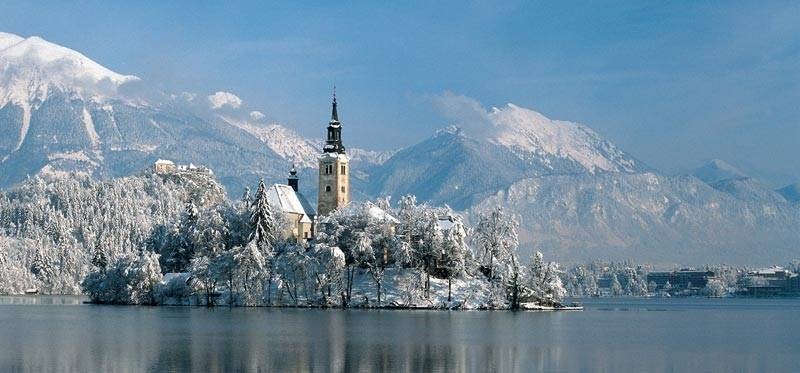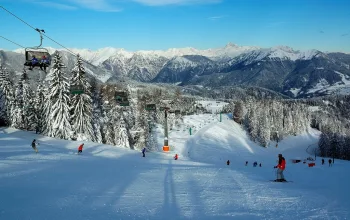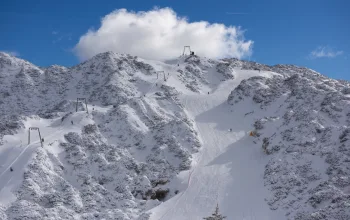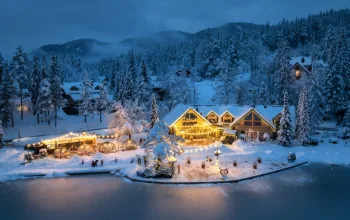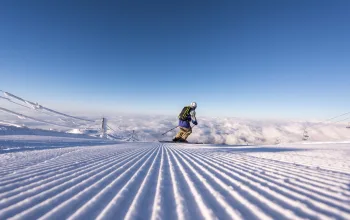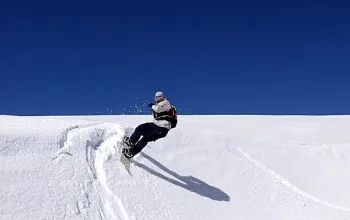The beautiful lakeside resort of Bled is close to three ski centres, the closest Straza is right above the old town, but has more limited terrain than better known Kobla and Vogel ski areas, 30 minutes drive away ( free ski bus for lift pass holders ) . Straza does have night-skiing however so is worth considering for an aprés - ski - ski.
Mountain
Bled's four main ski areas participate in a joint lift ticket scheme which provides a total of 88km (55 miles) of piste served by 22 lifts. They are all linked by a free ski bus service for pass holders. The nearest ski centre to the resort is at Straza, a comparatively new, modern area, constructed in 1990, at a height of 600m and only minutes away from the centre of Bled. It is equipped with snowmaking and night skiing facilities, a double chair lift and a rope tow. The latter is suitable for beginners and is used by the local ski school. Two ski slopes, in total about 1.2km (three quarters of a mile) in length are available for both beginners and experienced skiers. However anyone above beginner standard is unlikely to find more than a day's entertainment here. The next centre on the road out of town is Zatrnik, 10km (6 miles) away on the Pokljuka plateau. It is blessed with a chair and four T Bars serving 16km (10 miles) of runs for all standards, the longest 2.5km (just over a mile and a half). The vertical is 344m, three times that of Straza, and the top of the lifts at 1200m is twice as high. Zatrnik is another good place to learn to ski or progress with gentle open nursery slopes and some easy to use lifts. The chair serves long easy and intermediate runs from the area's highest point at Berjanca, and there are a couple of short sharp blacks from the top of the Hotunjski Vrh lift, one of which has staged world cup slalom races in the past. There is extensive cross country skiing in the area from a separate base at Pokljuka, a further 10km (6 miles) along the road, where the 35km (21 miles) of trails are supplemented by a single 200m drag for alpine skiers. The best known cross country trail is on Rudno Polje - a Biathlon World Cup event is held here every year. You can also go cross-country skiing on Zajavornik, Goreljek and in the Kranjska valley. The two 'serious skiing' centres are Kobla and Vogel - in Bohinj, only 20 and 30 km from Bled respectively. There is good snow here almost every winter, because the 36 trails on Vogel run from 1300 to 1800 m above sea level, and Kobla has snowmaking facilities. Both areas have a healthy 35km (22 miles) of trails, each with three chair lifts. Kobla has three additional drags, Vogel five drags and a cable car. Vogel's cable car rises above the forest from lakeside Bohinjsko Jezero up to a ski area base plateau that includes nursery slopes and chairs serving higher, steeper runs. Although official figures give a vertical of only 500m or so, an intermediate run back down to the base of the cable car is open if snow conditions permit, giving a world class drop of 1200m, the upper section of which may be completed on the area's single black, or an intermediate run giving the longest run of 6km (4 miles). From the top of Vogel you can have excellent views of Triglav, the highest mountain in Slovenija and indeed in the whole former Yugoslav Republic area. A similar vertical of nearly 1000 metres is possible for Kobla, again if snow conditions are adequate. Here there are easy runs at all levels with nursery slopes at the base. The three chair lifts take you in succession to 700 and then 1000 metres. The one short black is served by the middle chair.
Families
Facilities for children are limited with no day care and no ski kindergarten. Children from age 5 and over can join adult ski school (as is the common model in Italy), with no lunchtime cover available. Private lessons are the only option for younger skiing-age children although these are charged more reasonably than at most other ski areas. Details of babysitters are available from the tourist office or individual hotels. On the plus side prices are generally far more reasonable than at most international ski centres and there are plenty of child friendly facilities.
Eating Out
Bled's twenty plus eateries have a high reputation, especially the Villa Bled, a former favourite with the late President Tito. The restaurants in the hotels Golf and Park are also highly regarded. You can also eat in Bled Castlew, may be tempted by the Rot Inn or choose to visit the century old Restaurant Okarina. Bled is famous for its cream cakes which have now been known for decades as the symbol of Bled cuisine. The former manager of the Hotel Park, a Mr Lukacevic had the enviable job of testing recipes for many years before he finally succeeded. His cream cakes, prepared in house and sold in the café opposite the hotel, are famous. There is apparently no secret to the success in making the cakes, only experience. The cooks from Bled have plenty of that having made and sold more than 13 million cakes since 1960. The famous treats have a golden crispy crust made from butter dough (not margarine!), a delicious vanilla cream of exactly the right consistency (i.e. with exactly the right amount of flour - if there is too much, they are no good, if too little, they collapse after cutting). This is topped with whipped cream, then another crispy layer of butter dough covered with powdered sugar.
Apres
Après ski in Bled is generally relaxed and informal. There are several dozen bars and cafés, some with live music and of course prices are very reasonable compared to the Alps. A discothèque operates in to the small hours and there are, the tourist office believes, '100 things to do in Bled' besides. On the more unusual side these include listening to brass band concerts or just skating on the frozen lake. More conventionally you could visit the cinema, the bowling complex or the Olympic sized ice rink.
Boarding
Despite a positive attitude, opportunities for 'boarders are somewhat limited at Bled's five ski centres. On the plus side you can access most of the terrain, except for the former FIS slalom at Zatrnik, by chair lift or cable car. Unfortunately that FIS Slalom run is probably the best of only four blacks spread around the five areas, all of them rather short and not especially tough. The Zatrnik black is served by a T Bar. Other good points to bear in mind however are the natural terrain features on the slopes that are largely cut down through forest, and the high value prices on and off the slopes. The rather gentle terrain that predominates however may be a little too flat for many.



